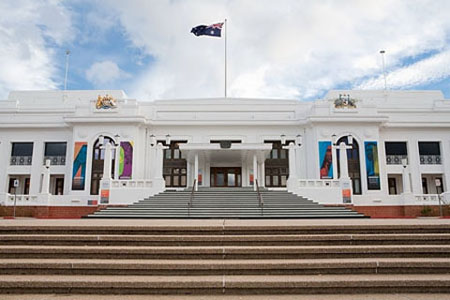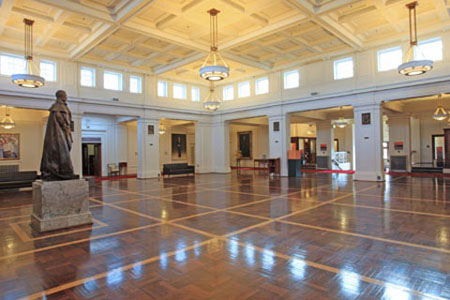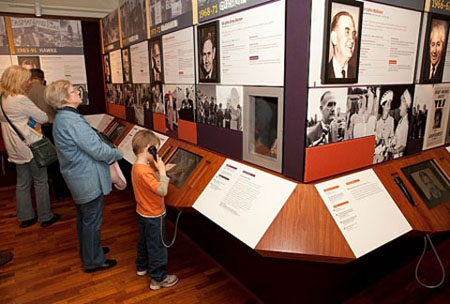
The Museum of Australian Democracy (MoAD) is a very welcome addition to Canberra and indeed won a regional tourism award in 2010. It helps ensure the future of a much-loved building, the Provisional Parliament House, designed down to its furniture by Commonwealth architect, John Smith Murdoch. The fabric of the building has been gradually restored since the rack and ruin it fell into after 1988 when the politicians moved up the hill. Some would have been happy to see it demolished, but thanks to the efforts of Senator Margaret Reid and others in the Canberra community it was reopened to the public in 1992 and is now on the National Heritage List.
The museum took a little longer. The Howard Government provided three years' funding for its development in 2006. It was opened on 9 May 2009, celebrating the day on which the federal parliament was opened in Melbourne by the Duke of York in 1901, the day the provisional parliament was opened by another Duke of York in 1927 (after coaching by speech therapist Lionel Logue) and the day the new Parliament House up the hill was opened by the Queen in 1988. This chronology illustrates one of the numerous paradoxes that are part and parcel of this museum. The museum may be a celebration of democracy and Australia's place in global democratic history but it is also a celebration of a building and the political scenes that have been enacted in and outside it, including demonstrations of loyalty to the British Crown.
The main hall of the building leads to the two chambers. It used to be where politicians, journalists and constituents mingled, where protests and political work took place and where John Curtin and Ben Chifley lay in state. This is of course 'King's Hall', dominated by a bronze statue of King George V and with paintings of royal openings in 1927 and 1974 on either side of the entrance to what is now Australian Democracy — More than 2000 Years in the Making.

What kind of democracy is this that is so deferential to an overseas monarchy? One where, as Paul Pickering points out, British ideas about free-born rights and democracy came in the luggage of Chartists and other political reformers, seeking to realise under the Southern Cross ideas frustrated at home, while still identifying with Britain. What might seem odd to overseas visitors seems natural to many Australians, if less so now than in the past.
In any case, once past the royal openings, we are into a sweep of democratic history that extends as far back as Mesopotamia in the accompanying film narrated by Geraldine Doogue. The film arrives at vox pops in modern Australia via classical Greece and Iceland, which celebrated its democratic millennium in 1938. Nelson Mandela also talks of his pride in a united, democratic, non-racist and non-sexist South Africa. Doogue earnestly and mistakenly tells us that most Australian women were able to vote in the first federal election (in fact only women in South Australia and Western Australia were able to do so).
Much fine work has gone into both telling engaging political stories by means of the fabric of the building and through the democracy exhibitions. But what is the general conception of democracy conveyed here? The 'vision' of the museum is 'to celebrate, debate and experience the journey of Australian Democracy'. While themes of exclusion and inclusion in that journey are well illustrated by reference to gender and race, class is signally absent. It would be difficult to understand from MoAD the extent to which democracy was once feared as a threat to property — the idea of democracy encapsulated in the words of the great Liberal anthem: 'Why should we be beggars with the ballot in our hand?'
In the mid-nineteenth century property won the day in the Australian colonies, defusing the threat posed by manhood suffrage. Plural votes for property owners continued until the 1890s in the lower houses of New South Wales and Victoria, while in Tasmania, Queensland and Western Australia they lasted even longer. Even more important was the constitutional entrenchment of powerful upper houses based on property franchises. The property franchises for upper houses are not ancient history — they lasted until 1964 in Western Australia, 1968 in Tasmania and 1973 in South Australia. Another way of shoring up the power of property was through rural weighting and zoning systems, so that rural votes were worth much more than city ones, both for lower and upper houses. Rural bias began to be addressed in the 1970s but was eliminated from the Victorian Legislative Council as late as 2003 and continues to exist in the Western Australian Legislative Council.
Devices such as property franchises and rural weighting helped ensure the interests of property were protected against the inroads of democracy; upper houses were most effective in, for example, stalling more equitable forms of taxation. So while for reformers democracy meant political equality and giving people the vote to balance the power of property, the bias in favour of property continued to be reinforced through electoral institutions.
There is a section in MoAD's main exhibition on 'suffrage', but this is only about women's suffrage, not about the long struggle to get rid of property franchises and eliminate plural votes, a struggle still not over at the local government level. I understand that there are plans to provide a broader presentation on the suffrage theme. The next theme is 'equality', but again this is about the specific issue of Indigenous rights, not about political equality more broadly construed. There is nothing on the major issues Australia is currently confronting concerning the role of corporate money in democratic elections. This kind of 'dangerous' theme is confined to activists whose concerns are projected on a semi-circular screen in the separate Living Democracy — the Power of the People exhibition.
And despite the focus of the museum on rights and freedoms rather than equality, one of the most dramatic episodes in our political history is not featured in the main exhibition — Dr Evatt's successful campaign in 1951 to mobilise public opinion to protect political freedoms. What accounts for this timidity in the presentation of events? Democracy is a radical ideal and inseparable from contention. Contentious matters need to be included, even if they are not settled. Does the status of MoAD as an 'executive agency' (rather than a statutory body) within the portfolio of Prime Minister and Cabinet, contribute to nervousness? At present the museum seems to be constantly looking over its shoulder to make sure there is nothing to offend the political sensitivities of either government or opposition. This nervousness may be well-founded, but 'balance' may be at the expense of history.
Apart from the neglect of political equality, there are other substantive issues to raise concerning the main democracy exhibition. There is nothing on John Stuart Mill, the leading nineteenth-century philosopher of representative democracy. Mill was the greatest single influence on Australian campaigns for women's suffrage and proportional representation. Two of his followers are specifically mentioned in the exhibition, Dr Edward Stirling, the author of the first Australian women's suffrage bill, and Catherine Helen Spence, leading campaigner for 'effective voting', but I could find nothing on Mill himself.
It was also one of Mill's disciples, Henry Chapman, who was responsible for the invention of the 'Australian ballot'. The invention of an effective mechanism for the secret ballot (namely a government-printed ballot paper with the names of candidates) is one of the great Australian contributions to democracy. Today the right to the secret ballot is enshrined in Article 25 of the International Covenant for Civil and Political Rights. The museum is wobbly about its introduction, sometimes forgetting that Tasmania shared the honours in 1856 and confusingly saying that the 'Australian ballot' came in 1858, actually the date when the superior South Australian ballot paper design was introduced.
The whole story about the role of the Australian ballot in transforming elections is worth telling, even if British novelists like Trollope believed it was 'unmanly' for voters not to be prepared to physically defend their electoral choices. It certainly paved the way for women's suffrage. Suitable objects to convey democratic ideas and innovations are difficult to find but the illustration of the secret ballot is particularly misleading. An 'Elector's Right' is used, a document issued in Victoria from 1863 to 1910 to enable men (and in the end, women) who were not on the ratepayers' roll to vote. So this would have been a good illustration for the suffrage section, but not for the secret ballot. There is an understandable shortage of democratic 'objects' — although the fund-raising Chartist shoe lent by the Powerhouse Museum is a highlight.
There is a general weakness in relation to women's political history, despite the obvious commitment to its inclusion. One of the most amusing slips is the insertion of a box explaining what a trade union is, in the midst of material about the Woman's Christian Temperance Union (WCTU). While the WCTU was certainly a critical actor in the gaining of women's suffrage, it was far from being a trade union. Other oddities include the date of 1895 both for women's suffrage in South Australia and for women voting for the first time. The correct date for the enactment of women's suffrage (and the date on the legislation) is 1894, while the next South Australian election was in 1896. The illustration provided for the women voting item might have provided a clue — it is a 1956 photo of members of the League of Women Voters at a 60th anniversary celebration. In any case, women ratepayers had voted in an 1864 Victorian parliamentary election, having been accidentally enfranchised the year before. As another example, it would have been helpful to look at the 1994 official history of the Office of the Status of Women before including an item about it in the timeline with the wrong date for its name.
The illustration provided for women's campaign to drink in public bars is a circa 1972 photo of men drinking in such a bar in Tasmania. Why not use the famous photo of Merle Thornton and Bo Rogner chained to the public bar in the Regatta Hotel in Brisbane in 1965? This event was reported around the world and provided the momentum for the creation of the Equal Opportunity for Women Association. Federal Labor parliamentarian Bill Hayden became a member and doggedly pursued its main objective, the removal of the Commonwealth marriage bar that had blighted so many women's lives. Surely this is the kind of democratic struggle that should have a place in this museum, and has the advantage of both being highly visual and having an already-existing documentary history (I confess, I am the author).
But enough quibbles. MoAD is doing a lot of things very well. Despite the disgruntled departure of Sir David Smith, the Museum has an army of well-informed and enthusiastic volunteer guides that includes psephologist Malcolm Mackerras. It has a great array of participatory activities for school students, including decision-making and voting on hot topics and interactive experiences using RFID (Radio Frequency Identification). With a swipe card, students can access customised content on the screens in three main exhibition areas. They can engage in deliberation and decision-making and record how they respond to the process. Adults can also engage in voting on different issues on their way through exhibitions and get immediate feedback as to the balance of opinion. For example, on the day I visited, 68 percent of voters were opposed to governments being able to ban books.
One popular area is the Prime Ministers of Australia exhibition, which has a particularly engaging series of short films narrated to camera by Warren Brown about objects associated with different Prime Ministers (such as the 'Vote Yes' button from one of Billy Hughes's conscription referendums). A strength of the museum — and something very Australian — is the use of the work of political cartoonists to help tell its stories. The Living Democracy exhibition also makes good use of social movement songs as well as illustrating lobbying techniques through the National Farmers' Federation and recent electronic campaign repertoires through GetUp!

| Institution: | Museum of Australian Democracy |
| Curator: | MoAD acknowledges the contribution of all staff |
| Venue/dates: | Old Parliament House, 18 King George Terrace, Parkes, ACT, ongoing |
